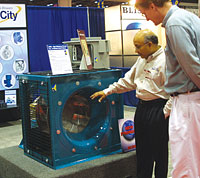
Air Balance (www.air-balance.com) introduced its A320 severe weather louvers. According to the manufacturer, the A320 was de-signed to protect against missile impact and severe wind loads, including hurricane-force winds, and it has passed the most stringent tests to date. The A320C has gone one step further by passing Test Protocol PA-100, allowing zero water penetration into the building. Michael Binkholder said the louvers were designed with a unique installation method to further reduce installation time and the amount of building steel required.
Arzel Zoning Technology (www.arzelzoning.com) highlighted its new modulating bypass control for zoning variable-speed systems. This state-of-the-art static control can be set from 0.05 to 0.5 inches water column, and contractors can dial in the static pressure.
Broan (www.broan.com) introduced its designer fan/lights, which offer two power and sound levels, both appropriate for a wide range of bathroom sizes. Four models offer 70 cfm with a sound level of 3.5 sones, while three models feature 85 cfm at 2.5 sones. The company also showcased its new QT Series of bath fans, which are some of the industry's quietest fans, noted Karen Collins, marketing communications manager. The complete line of QT fans has sone levels ranging from 0.3 to 1.5 and models are available in sizes ranging from 50 to 150 cfm.

Jackson Systems (www.jacksonsystems.com) introduced its low-cost electric retrofit zone damper. This low-cost damper is constructed of heavy-gauge steel and works with most zone systems. Tom Jackson also noted the company was showcasing its new modulating Zone One diffuser. The diffuser is available in two-position or modulating and round or rectangular. Controls are pre-wired from the factory, and no control panel is required.Krueger (www.krueger-hvac.com) showcased its new RadiaFlo flush-face radial diffuser for critical rooms. Justin Anderson stated that the new diffuser delivers a uniform 180-degree radial air pattern in order to eliminate drafts that could negatively affect laboratory ventilation and fume hood containment. The company also highlighted its LineaHeat, which is an electric heating option for VAV terminal units. This electronic, time-proportional digital relay version of Krueger's electric heat product line is available with an optional discharge temperature sensor.
Moffitt Corp. (www.moffitthvac.com) introduced its Hurricane industrial wind-driven turbine ventilator. John Moffitt stated that the ventilator works with no electrical power, needs no maintenance, and is made of recycled materials. "By using this ventilator, industrial applications such as paper mills and distribution centers can ventilate their plants for free," noted Moffitt.
Panasonic (www.panasonic.com/building) introduced its WhisperCeiling and WhisperLite ventilation fans. National accounts manager Farell Beddome stated that the fans are the quietest ventilation fans in the industry.
"We totally re-engineered the products," she said. "The new two-storied, double-tapered, dolphin shaped blades move the air much more efficiently than a flat blade." The WhisperLite ventilation and light combination features new electronic ballast technology and better than 30-percent improvement in brightness, said Beddome.
Rosenburg USA (www.rosenburgusa.com) highlighted its EC Solutions fans. The new fans reduce energy costs and feature integrated electronic motors, backward-curved centrifugal fans from 133 to 225 mm, and single-inlet centrifugal fans from 108 to 160 mm. Options include constant airflow, constant pressure, and three speed configurations.
Ruskin (www.ruskin.com) introduced its EAML6625 and EAML3625 louvers, which incorporate an air measuring station to ensure buildings receive the proper amount of fresh air in workspaces. These louvers require only a few inches of installation depth and perform the same function as separate louvers and air monitors that require several feet of installation depth, according to the manufacturer. By providing this factory-installed, integrated solution, noted Dan Rellihan, Ruskin helps create and maintain healthy buildings while saving contractors hours of installation time and money.
Titus (www.titus-hvac.com) introduced the TFS and Fantom IQ fan-powered terminals. These are two products that resulted from engineers and contractors requesting a smaller, quieter, less costly fan box than previous terminal units on the market. The terminals utilize the FAST attenuator system, which reduces radiated sound power levels. The Fantom IQ is available with an ultra-high-efficiency GE ECM motor.
Tjernlund (www.tjernlund.com) featured its CPC-3 constant pressure controller for modulating draft and combustion air system. The CPC-3 functions as the brains of Tjernlund's smart mechanical vent systems to simultaneously monitor and adjust fan speed to maintain optimum draft and/or combustion air. Rick Wagner stated that the CPC-3 varies the speed of the fan to give the perfect amount of air.
Twin City Fan (www.twincityfan.com) featured its airflow measuring system using a piezometer ring. This air measuring device is an option on centrifugal fans and is based on the principle of a flow nozzle. The inlet cone of the fan is used as the flow nozzle, and by measuring the pressure drop through the inlet cone, the flow can be calculated. The system consists of a piezometer ring mounted in the throat and a static pressure tap mounted on the face of the inlet cone. A differential pressure transducer and a digital display can be provided.
Publication date: 02/28/2005


Report Abusive Comment